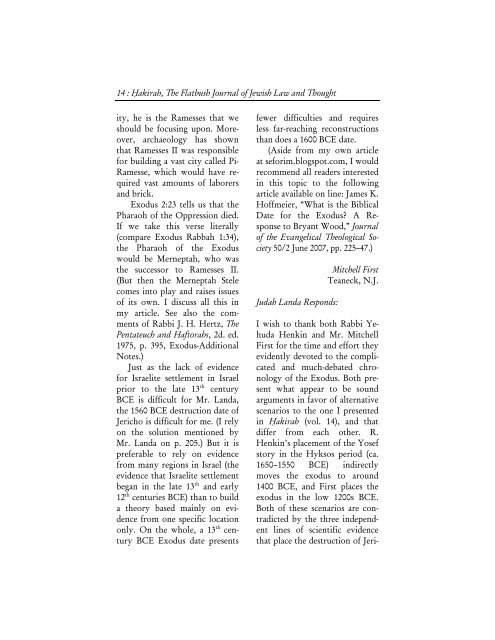the letter. - Hakirah.org
the letter. - Hakirah.org
the letter. - Hakirah.org
Create successful ePaper yourself
Turn your PDF publications into a flip-book with our unique Google optimized e-Paper software.
14 : Hạkirah, The Flatbush Journal of Jewish Law and Thought<br />
ity, he is <strong>the</strong> Ramesses that we<br />
should be focusing upon. Moreover,<br />
archaeology has shown<br />
that Ramesses II was responsible<br />
for building a vast city called Pi-<br />
Ramesse, which would have required<br />
vast amounts of laborers<br />
and brick.<br />
Exodus 2:23 tells us that <strong>the</strong><br />
Pharaoh of <strong>the</strong> Oppression died.<br />
If we take this verse literally<br />
(compare Exodus Rabbah 1:34),<br />
<strong>the</strong> Pharaoh of <strong>the</strong> Exodus<br />
would be Merneptah, who was<br />
<strong>the</strong> successor to Ramesses II.<br />
(But <strong>the</strong>n <strong>the</strong> Merneptah Stele<br />
comes into play and raises issues<br />
of its own. I discuss all this in<br />
my article. See also <strong>the</strong> comments<br />
of Rabbi J. H. Hertz, The<br />
Pentateuch and Haftorahs, 2d. ed.<br />
1975, p. 395, Exodus-Additional<br />
Notes.)<br />
Just as <strong>the</strong> lack of evidence<br />
for Israelite settlement in Israel<br />
prior to <strong>the</strong> late 13 th century<br />
BCE is difficult for Mr. Landa,<br />
<strong>the</strong> 1560 BCE destruction date of<br />
Jericho is difficult for me. (I rely<br />
on <strong>the</strong> solution mentioned by<br />
Mr. Landa on p. 205.) But it is<br />
preferable to rely on evidence<br />
from many regions in Israel (<strong>the</strong><br />
evidence that Israelite settlement<br />
began in <strong>the</strong> late 13 th and early<br />
12 th centuries BCE) than to build<br />
a <strong>the</strong>ory based mainly on evidence<br />
from one specific location<br />
only. On <strong>the</strong> whole, a 13 th century<br />
BCE Exodus date presents<br />
fewer difficulties and requires<br />
less far-reaching reconstructions<br />
than does a 1600 BCE date.<br />
(Aside from my own article<br />
at seforim.blogspot.com, I would<br />
recommend all readers interested<br />
in this topic to <strong>the</strong> following<br />
article available on line: James K.<br />
Hoffmeier, “What is <strong>the</strong> Biblical<br />
Date for <strong>the</strong> Exodus A Response<br />
to Bryant Wood,” Journal<br />
of <strong>the</strong> Evangelical Theological Society<br />
50/2 June 2007, pp. 225–47.)<br />
Judah Landa Responds:<br />
Mitchell First<br />
Teaneck, N.J.<br />
I wish to thank both Rabbi Yehuda<br />
Henkin and Mr. Mitchell<br />
First for <strong>the</strong> time and effort <strong>the</strong>y<br />
evidently devoted to <strong>the</strong> complicated<br />
and much-debated chronology<br />
of <strong>the</strong> Exodus. Both present<br />
what appear to be sound<br />
arguments in favor of alternative<br />
scenarios to <strong>the</strong> one I presented<br />
in <strong>Hakirah</strong> (vol. 14), and that<br />
differ from each o<strong>the</strong>r. R.<br />
Henkin’s placement of <strong>the</strong> Yosef<br />
story in <strong>the</strong> Hyksos period (ca.<br />
1650–1550 BCE) indirectly<br />
moves <strong>the</strong> exodus to around<br />
1400 BCE, and First places <strong>the</strong><br />
exodus in <strong>the</strong> low 1200s BCE.<br />
Both of <strong>the</strong>se scenarios are contradicted<br />
by <strong>the</strong> three independent<br />
lines of scientific evidence<br />
that place <strong>the</strong> destruction of Jeri-
















